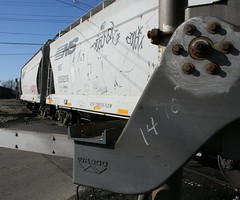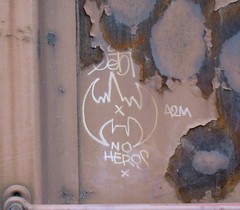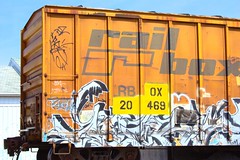The evolution of railroad graffiti
Graffiti, whether it's called art or vandalism, is a fact of modern railroading. But it didn't always look like what we see on the trains passing us today. Railroad graffiti has evolved over the past century and a half from simple chalk marks left by railroad workers to notify other workers of issues to marks left by hobos to vanity tags made in permanent ink to the elaborate and often enormous painted "pieces" (as they're termed by those who create them) of today. Let's take a look at how these markings were developed and, for those interested, how to model them.
One important note is needed before we begin a more thorough investigation. Throughout this article, I will use the word "graffitist" to refer to the person who applies the graffiti (in the same sense as a therapist is a person who provides therapy or as a chemist is a person who works with chemicals). One group people will vigorously defend the markings that others leave as an artistic expression while another group of people will vehemently denounce graffiti as a destruction of property. Whether graffiti is art or purely vandalism is beyond the scope of this article, so I am purposely avoiding certain phrases in an attempt to avoid the argument here, and therefore I will not explicitly state my own opinion on graffiti itself.
Railroad employee markings
The first markings that were applied to the sides of railroad equipment were made by railroad employees themselves sending messages to each other. The messages could relate to handling of a specific car or load, the condition of equipment that needs repair or simply an indication of an item's dimensions (as can be seen on the grade crossing arm in the image to the right). Since these marks more often than not were relevant to the locations where they were placed and necessary for the safe and efficient operation of the railroad, they really weren't graffiti. These marks generally weren't applied as a way to say "I was here," but rather to convey important information that other railroad employees would need to know in order to perform their duties.
Modeling railroad employee markings
Strictly speaking, dimensional and repair data are markings applied by railroad employees, and decals including this data are widely available commercially from almost all decal manufacturers. However, the type of markings that are discussed here generally don't appear on commercial decal sets and must be created by hand. In larger scales, you may be able to simulate some markings by using a fine-tipped pen and writing the marks by hand. For smaller scales, or if your freehand skills aren't quite what you'd like them to be, this could be the perfect opportunity for you to learn how to print your own decals on an inkjet or laser printer (which is beyond the scope of this article).
Hobo signs
Since the railroad employees were using chalk symbols to communicate, it was only natural that the next class of people to be around freight equipment on a regular basis, hobos, would also start using chalk markings to communicate with each other. One item to keep in mind here is that just as there are different dialects of the English language around the country (do you know what a "bubbler" is or what it means to be a "budger"?), hobo signs tend to vary by region as well. Not all hobos traveled the entire country; sometimes called "harvest hobos", some kept to specific regions and would often follow the various farm harvests around the region.
Tags
A tag is, in its most basic form, the name of the person leaving the mark. The origins of pen and ink tags are often traced to New York City in the late 1960s and early 1970s. Some of the city's younger residents began writing their name and the street number on which they lived using markers and other pens on surfaces near them. Since many of them rode the subway on a regular basis, the tags started appearing on subway equipment to allow the tags to spread throughout the city.
Art/cartoon monikers
With this type, the person applying it adds a small line drawing to the signature. This was probably also a development of the graffitists trying to differentiate their tags from those around them. The drawing could be a political message, or could simply be something that the tagger likes to draw. These are often smaller drawings that are not noticeable from a distance, but they can be just as creative in the images or messages depicted. However, the simple line drawings of a moniker with or without a message can be as big as the entire car side, as we see on this tank car spotted in Long Beach, California.
Modeleing art/cartoon monikers
Some of the more common monikers, such as those made by Colossus of Roads or Whistleblower, have been applied to so many freight cars that decals may be commercially available from smaller decal manufacturers (I've seen commercial decals that include these two and several others on one sheet). For others, the easiest option to model them may be to use a fine-tipped pen to draw the moniker by hand. This has the obvious advantage that what you write on your equipment will be unique and will show some variation, as can be seen on the prototype, but your reproduction may turn out to be unique enough that it is no longer an accurate representation of a real moniker. But then, depending on your point of view and modeling preferences, this could be a good thing.
Pieces
The word "piece" in this context stems from the word "masterpiece" which is meant to indicate that the graffiti is more than just a scribbled name. The graffitist may have taken upwards of a few hours to design the work on paper and then a few more hours to apply the work with spray paint and/or rollers to the chosen location. Beginning in the early 1970s, the simple signature tags evolved into the more complex styles that are now seen. This was partly a result of so many similar tags being applied that the graffitists started to write their tags with larger characters and larger pens, then adding outlines and other flourishes to them in order to distinguish their tags from the multitude of others around them.
Types
Graffiti pieces can be subdivided into three categories: signatures, purely artistic or a combination of the two.
Modeling pieces
The fastest and easiest way to model pieces is to purchase decals of them. A number of decal manufacturers produce decals containing pieces ready to be floated and applied to your models in most of the popular modeling scales. These commercial decals more often include only the signature type of pieces, but the artistic and mixture pieces can also be found commercially. Often, the decal will be a reproduction of an actual piece that was seen "in the wild," that is applied to an item of rolling stock that is in active service. When this is the case, of course, that means that you have a chance of seeing the piece you've just applied on your models somewhere out on the prototype.
Overpainting and cleanup
The majority of railroad companies officially view graffiti as vandalism and will, with varying degrees of expediency, paint out part or all of the graffiti. This may be done to restore the federally required reporting marks and dimensional data to the sides of the cars, or it may be company policy to completely paint over any graffiti when equipment is sidelined for service.
Modeling overpainting
To model equipment where graffiti was completely painted out, simply paint an appropriate-sized patch on the side of the equipment (or the end or the top; wherever you think the graffiti would have been left) in a different color from the surrounding area and then letter it as you normally would. The color you choose for the patch could be lighter or it could be darker or it could be a completely different hue. The patch does not need uniform or straight edges on it either. You could even use colored decal paper or a marker instead of paint to apply the patch. The key here is that the railroad may opt to use the least expensive method available to obscure the graffiti, and because of that, you may even find some where the obscuring paint has faded or flaked away enough that the graffiti shows through like a fallen flag herald on older equipment. Use your imagination here and go wild.
Sources
Acknowledgments
Thanks to those who I asked to review this article for both readability and accuracy. Their feedback has proven invaluable. Out of respect for privacy and to prevent their inboxes from getting filled with spam, I thank them as a group.







